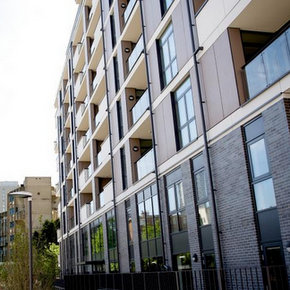
‘Affordable homes’ building at 25 year low
 Howard Chapman, Buildingtalk Editor looks at the latest ‘Affordable Housing Supply’ report that shows 52% fewer affordable homes have been built than last year – and the lowest number for 25 years. Homes are a key part of the infrastructure of the nation and we need find new solutions that offer a realistic prospect of ‘affordable homes for all’.
Howard Chapman, Buildingtalk Editor looks at the latest ‘Affordable Housing Supply’ report that shows 52% fewer affordable homes have been built than last year – and the lowest number for 25 years. Homes are a key part of the infrastructure of the nation and we need find new solutions that offer a realistic prospect of ‘affordable homes for all’.
Affordable Housing Supply report
The Department for Communities and Local Governement has just published its latest ‘Affordable Housing Supply’ report that shows the level of affordable house building has dropped to the lowest for 25 years with just 32,110 affordable homes were delivered in England in 2015/16. This included 6,550 social rent, 16,550 affordable rent and 9,010 affordable home ownership, shared ownership and intermediate rent.
52% less new affordable homes
Overall, this is a staggering 52% lower than the number of affordable homes built in the previous year. However, this reflects the transition from the 2011- 2015 programme to a new Affordable Houses and Shared Ownership programmes that should help improve the numbers going forward. But this is not going to meet the growing demand for affordable housing.
Housing Crisis
This latest report on the shortage of affordable housing is just one of many recent reports into Britain’s housing crisis.
The Redfern review detailed the catastrophic slump in home ownership as real house prices jumped 151% since 1996, while real earnings rose only by a quarter of this.
Pete RedfernChief Executive at Taylor Wimpey said in the preface to the report “The nation faces a housing crisis, at the heart of which is the falling rate of homeownership”. But it could be argued that the recent focus has been almost solely on new build homes that have made a few housebuilders big profits (including Taylor Wimpey – last full year profits up 34%), but does not address the massive shortfall in affordable homes to buy or rent.
Build-to-rent boom with new investors
The private rental sector is becoming increasingly important. The government set up a £1 billion fund to pump-prime build-to-rent projects. Estate agent Knight Frank estimates that £15bn has already been invested this will grow to nearer £50bn by 2020.
New large corporate investors are coming into the build to rent market including the big UK insurance companies like Legal & General and Aberdeen Asset Management, plus investors from Sweden, Germany and Canada, and US companies like Greystar.
Could new rail and road projects deliver housing?
Some of the major infrastructure transport projects could also help deliver affordable housing if the government decides that the supply of affordable housing should be part of the UK infrastructure plan. For example, Crossrail 2 could deliver huge amounts of housing in the capital but only if the government devolves powers to London councils. Back in the summer this created headlines that highlighted the opportunities by saying that Crossrail 2 could become a ‘housing project with a railway thrown in’.
Affordable homes for all
Continuing as we are is making the situation worse, with ever more expensive homes, less available land and a shortage of skilled workers.
We need a vision that sees affordable homes for all as part of the real infrastructure of the nation, and a vision that offers new solutions.
Links to related statistics
Affordable starts and completions funded by the HCA and the GLA
Delivery of affordable housing in London
Help to Buy (Equity Loan scheme)
One comment on “‘Affordable homes’ building at 25 year low”
Leave a Reply
You must be logged in to post a comment.
Latest news

22nd November 2024
Insight Data: Using Marketing Data to Build a Successful Business in 2025
Alex Tremlett, Insight Data’s Commercial Director, discusses the challenges for construction firms in 2025 and shares six strategies for success…
Posted in Articles, Building Industry News, Building Services, Information Technology, news, Research & Materials Testing
22nd November 2024
Purplex: A tough Budget, but opportunity still knocks
Incoming governments, especially those with significant mandates, inevitably come into power on a tidal wave of optimism coupled with hope that ‘Things can only get better’. Andrew Scott, MD of construction-focused, full-service agency Purplex, talks…
Posted in Articles, Building Industry News, Building Services, Information Technology, news, Posts, Research & Materials Testing
22nd November 2024
Pop Up Power Supplies Gets Arty in Yorkshire
Pop Up Power Supplies has installed 13 new electricity units at The Hepworth Wakefield – read more in this article…
Posted in Articles, Building Industry News, Building Products & Structures, Building Services, Case Studies, Civil Engineering, Facility Management & Building Services, Garden, Hard Landscaping & Walkways, Landscaping, Posts, Restoration & Refurbishment, Retrofit & Renovation
22nd November 2024
OPT Services Revolutionises Fibre Cable Capping with Eco-Friendly Innovation
UK-based OPT Services has unveiled SlimLine™ Capping, a groundbreaking fibre cable protection solution that promises to deliver significant environmental and installation advantages to the fibre optic industry.
Posted in Articles, Building Industry News, Building Products & Structures, Building Services, Facility Management & Building Services, Information Technology, Innovations & New Products, Sustainability & Energy Efficiency

eMoov chief executive Russell Quirk, speaking to Business Insider UK, said that he believes that the government needs to go further to have any chance of mending ‘Britain’s broken housing market’.
Here are his top suggestions:
1. Re-designate the swathes of unattractive parts of the green belt as ‘grey’ belt. He says many parts of the green belt are neither rural nor picturesque and should be exempted from the policy. For example, industrial estates, scrap yards, etc. that are technically in the green belt but should all be reclassified as “grey belt” to enable planning officers to approve housing developments on this land.
2. Force councils to identify their own land that is not being used. A system of incentives and penalties for councils could ensure that the scheme is implemented, rather than simply being talked about.
3. Set up a government-owned development company. He means a government-owned developer, not a panel or a commission. One that identifies suitable land, takes a planning application through the formal process itself, hires the construction contractors, and builds the housing itself.